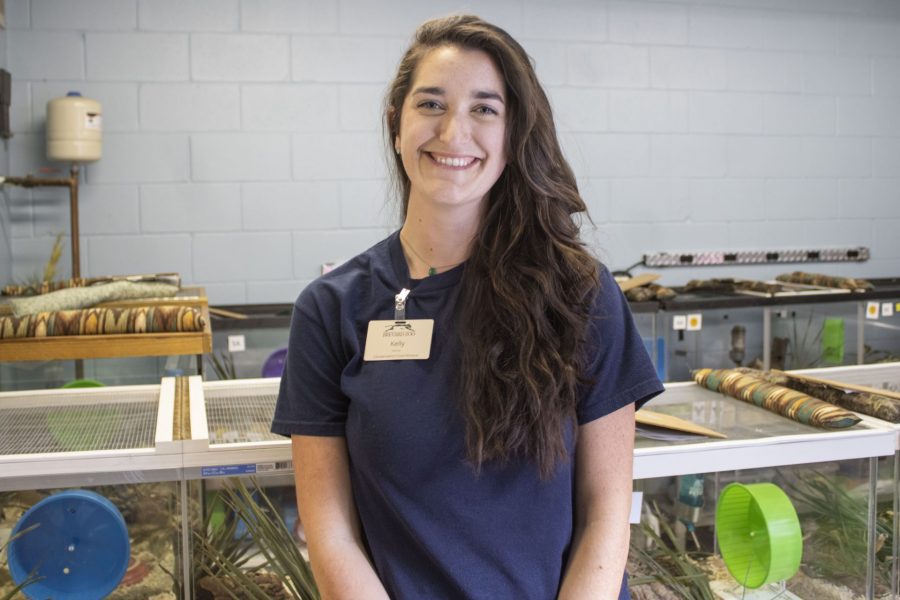

Meet Kelly Currier, our Conservation Coordinator.
This International Day of Women and Girls in Science, we wanted to introduce you to a few of our Zoo team members and get their insights on their fields. There are so many ways for women and girls to use their science degrees to impact the people and animals around them!
Meet Kelly Currier, our Conservation Coordinator! To read more of our Women in Science stories, check out this link.
Position with Brevard Zoo: Conservation Coordinator
Education: Bachelor of Arts in Zoology
How did you choose your field? I chose this field because I’ve been passionate about wildlife since I was a little girl, and I’ve always wanted to find a way to help the species that were struggling. I didn’t discover the Wildlife Conservation field until I was in college, but when I finally met the people that were studying animals and their ecosystem habitats, I knew it was where I belonged.
Did or do you have any female mentors or role models in your field? If so, how did they shape your career journey? My first role models in my field were Rachel Carson and Sylvia Earle. Both ground-breaking biologists and environmental justice advocates. They were some of the first women scientists to be vocal and take activist roles – speaking accessibly to the public while still doing important research. They’ve inspired me and shaped my career journey by showing me that you don’t have to fit into a certain mold to fight for wildlife. You can be a writer, a speaker, a mother and still be a strong scientist. We need all types of people in this field to move forward toward our goals, and they’ve showed me that I belong here. Another person that’s helped shaped my career is Colleen Adams – my first mentor as a zookeeping intern. She has advocated for me and encouraged me to no end, which has shown me the power of kindness and mindfulness in the workplace.
How would you describe your work at the Zoo? My work at the zoo is like that of a zookeeper! Except all of the animals that I care for are behind the scenes and live in wild-type habitats with very little human interaction. I care for Florida grasshopper sparrows, Perdido Key beach mice, and frosted flatwood salamanders – all tiny endangered species native to Florida! The zoo is working on projects with all three species in hopes of boosting their numbers in the wild. All the animals I take care of have a safe space here to breed and thrive, and all have the potential of being released. My job is to give them everything they need in all the important stages of life so that they can be successful in the wild. I also do a lot of coordinating with field crews and outside partners to ensure our recovery plans for these species are successful. Additionally, I help in our Sea Turtle Healing Center assisting with turtles being rehabilitated.
What do you enjoy about your job? I really enjoy getting to work with all of the different agencies that are involved in species recovery – the feeling of a team all coming together to protect animals is a wonderful thing to be a part of. I love getting to know the intricacies and behaviors of each species I care for, and I love providing them with what they need to thrive and feel safe. I enjoy sharing the beautiful things about these tiny creatures with the world and getting to show everyone how important each animal is to our ecosystems! My job is amazing because I get to help species that desperately need the help because of dwindling habitat/resources, and that’s been my passion all along.
What are some challenges about your work? A challenging part of my field of work is that trying to protect a species from going extinct involves fighting a lot of pressures, and a lot of times our attempts fail. It involves many people and many small moving parts, and sometimes it takes years to see any results. The losses can be discouraging. But the one project that IS successful, or the one turtle that is rehabbed and sent back to the ocean – these things make the entire fight worth it. I’d rather save or help one animal than help none at all.
What advice do you have for girls or women who want to work in your field? My advice for girls and women in my field is that if wildlife conservation is your passion and it’s where you want to put your energy, then there is a place for you here. We need all types of people with all types of strengths. Even though this work has been historically done by men, we are moving toward a much more inclusive group of researchers, animal care specialists and policy makers. Women in STEM are a huge part of the future of wildlife conservation. Chase whatever dream you have when it comes to conservation – the journey of the chase will be an unforgettable experience.
Brevard Zoo is an independent, not-for-profit organization that receives no recurring government funding for our operating costs. Your generous support enables us to continue to serve our community and continue our vital animal wellness, education and conservation programs.